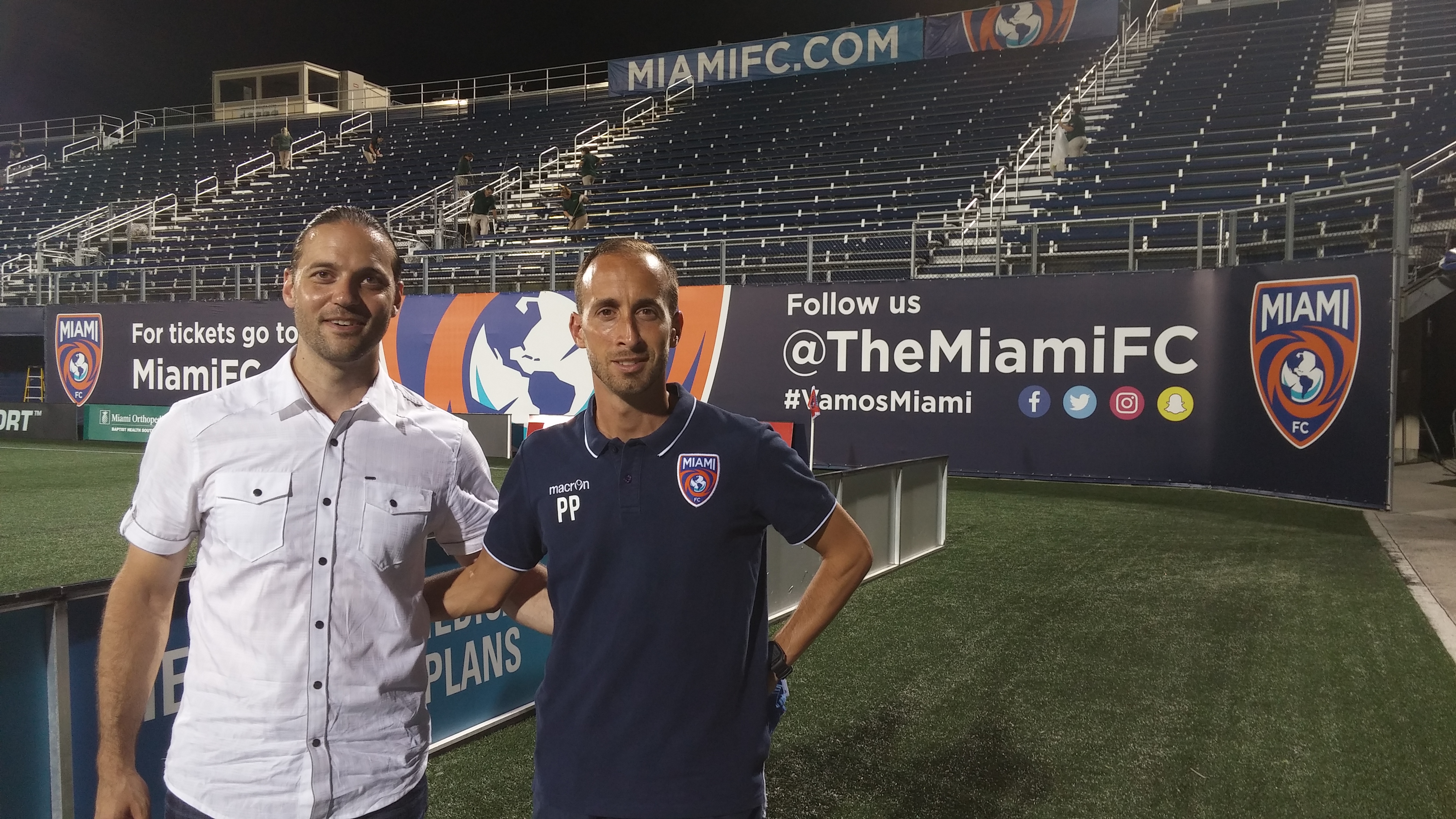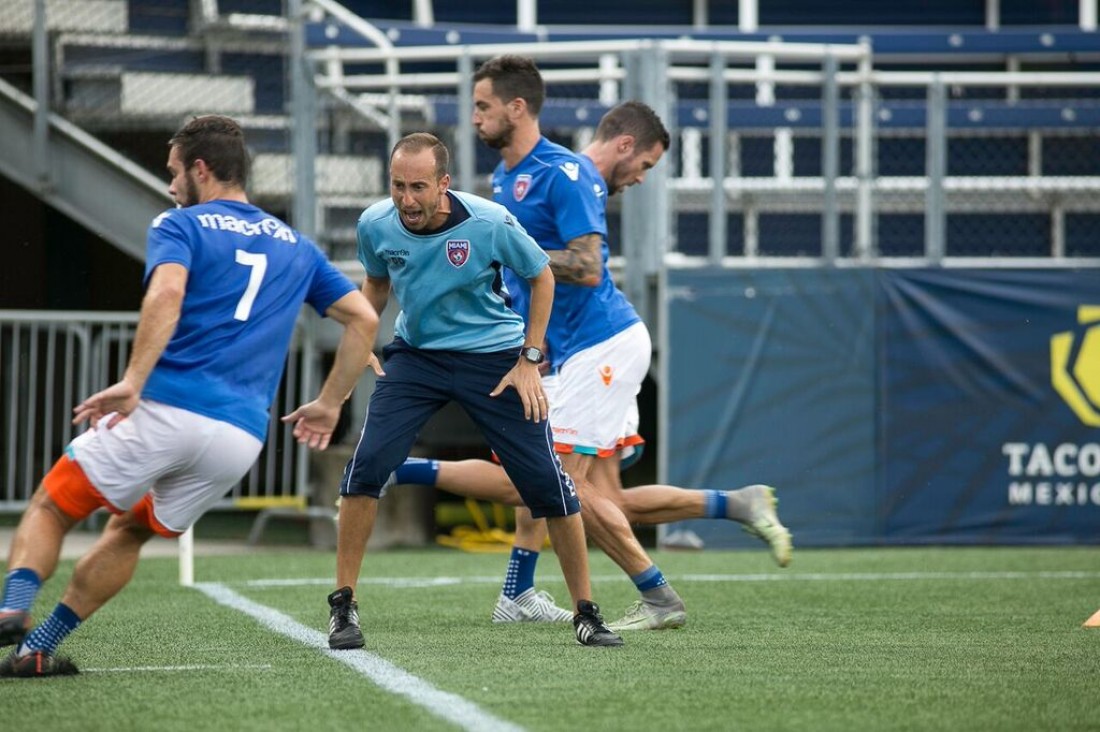(Photo credit: The Miami FC).
On the week of August 7th-13th, 2017, I visited my old friend and colleague Paolo Pacione, who has been the Head of Fitness and Performance at the Miami FC of the North American Soccer League for the past 2 years.
Pacione has had an extensive background working at the highest levels of the game in North America – including the Toronto Lynx of the A-League, various clubs in the Canadian Professional Soccer League, the Canadian Men’s and Women’s National Teams, and the Montreal Impact of Major League Soccer – and internationally, having worked with Faenza Calcio, a professional club in Italy.
He and the staff at the Miami FC, including Head Coach Alessandro Nesta, were gracious enough to allow me to sit in on an entire week of their training, leading up to their home game versus the Indy Eleven on Saturday, August 12th.
One thing I saw during training that week which was very interesting to me – primarily because it is so rare in Canada, even in the higher levels of the game in which I have worked over the past few years – was that at the Miami FC, the Fitness Coach was integrated into, and had a hand in planning, all aspects of the team’s training – not just the “physical” part of the sessions.
This means that Pacione works as part of the Coaching Staff – through a collaborative process in which Head Coach Nesta – who met Pacione in his final season of professional soccer, when Paolo was the Fitness Coach of Montreal Impact – draws upon the knowledge and experience of all of his supporting staff in order to optimise the planning of training, from the first minute of the warm-up to the final minute of the small- or large-sided games.
Why is the integration of the Fitness Coach into the planning of all training so important? Simply put, it is the only way to ensure the optimal training environment for players, and thus the only way to ensure optimal performance of players in training and game play.
I’ve written about this topic before, including as a means of explaining the rationale behind the creation of my Soccer Fitness Trainer’s Courses, which teach Canadian amateur club/academy soccer coaches how to plan and implement physical fitness training into their sessions in the absence of a professional fitness coach (a reality for the majority of amateur clubs and academies in Canada).
In the elite Canadian soccer environments, including university Varsity teams, Provincial and National Teams, and professional Academies and First Teams, coaches should not be expected to plan and implement fitness training on their own, nor should this work be passed off onto Athletic Therapists or other staff, as is unfortunately too often the case.
Professional Fitness Coaches must be an integral part of the Coaching Staff in these environments if we truly wish to optimise player development at the youth level, and player performance at the adult level.
How can we be sure that this model is effective? In professional soccer, results are what matter most. And in the case of the Miami FC, the results speak for themselves. The club, in only their second full season in the North American Soccer League, finished the 2017 Spring Season in first place, with 36 points from 16 matches – a full 10 points ahead of their closest rivals the San Francisco Deltas – and securing a play-off spot for this coming November.
After a slow start to the 2017 Fall Season, to date the teams sits tied with Puerto Rico FC for first place in the league, with 9 points from 5 matches.
The Miami FC also had a successful run all the way to the Quarterfinals of the 2017 U.S. Open Cup – the oldest national soccer competition in the United States open to all professional clubs in the country – During which they secured victories over Major League Soccer clubs Orlando City SC in the Fourth Round, and Atlanta United in the Round of 16.
In addition to the results on the pitch, the professional, positive, “winning” environment created by the Coaching Staff was clearly evident to me as I observed the team’s training all week. The players were respectful, hard-working, eager to learn and very responsive to the instruction and training they received, all of which was of the highest quality. Team morale could not have been higher than it was during the final training session prior to their match on the 12th – always a good sign.
They ended up winning convincingly, by a score of 3 to 1.

Credit for the team’s success must be given at least in part to the synergy that exists between the Coaching Staff, at the centre of which is Fitness Coach Pacione. He has developed an efficient working relationship with the rest of the Coaching Staff at the Miami FC, built on trust and mutual respect of each person’s unique knowledge, experience and abilities.
Many Canadian coaches and fitness coaches presently working in high performance environments could stand to learn a thing or two from the example set by Pacione and the Miami FC. If we are truly serious about optimising player development and player performance in these environments, we need to find, train, and empower Fitness Coaches, and fully integrate them into their respective team’s Coaching Staff.
I’d love to hear your thoughts and comments about this article. Please drop me a line here to get the conversation started.


Would you recommend drills that have a fitness component to increase soccer abilities and increase fitness at the same time? SSG are usually what I have used in the past to assist with soccer skills and fitness.
Hi Roberto,
thanks for your message/question! Yes – actually, small-sided games are probably the best way to train for soccer-specific fitness. You get all of the running, changing direction, etc. and it is the most specific to the game as possible!
Hi my name is Norman.
I will be in miami the week 0f 14 Sept.
I will like to see a practice of miami with Mr.pacione.
How can made that possible?
Thanks.